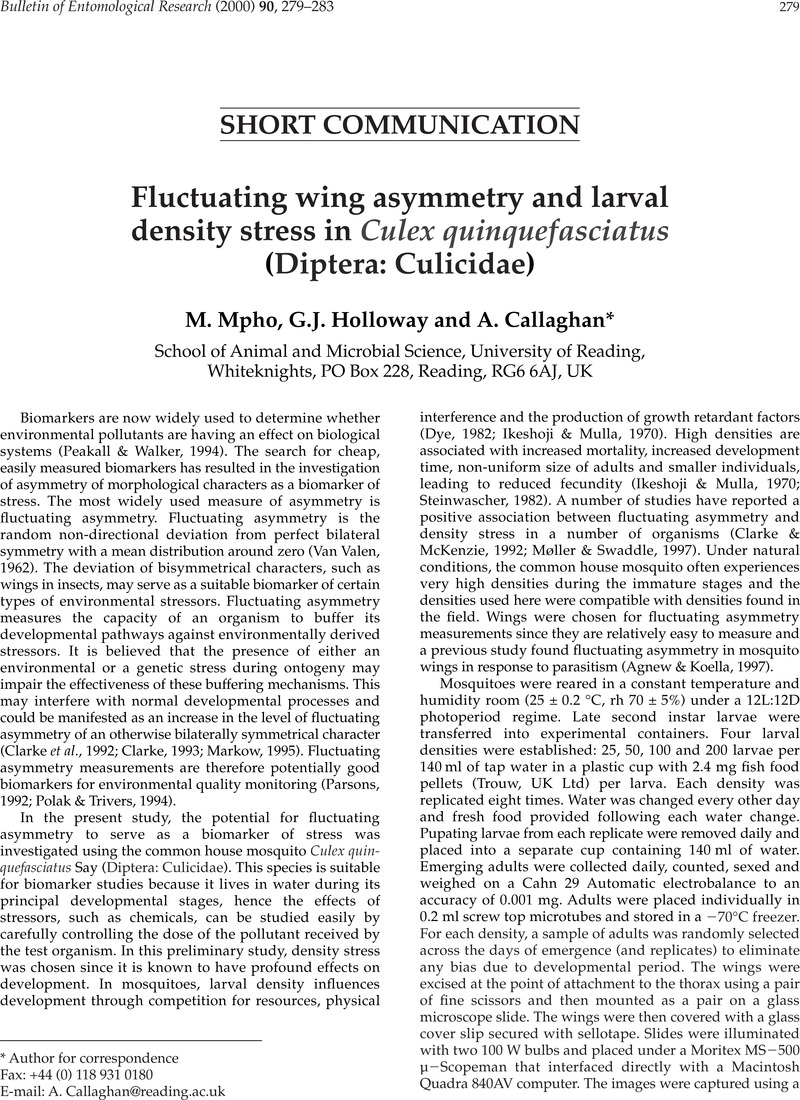Crossref Citations
This article has been cited by the following publications. This list is generated based on data provided by Crossref.
Mpho, Mandla
Holloway, Graham J
and
Callaghan, Amanda
2001.
A comparison of the effects of organophosphate insecticide exposure and temperature stress on fluctuating asymmetry and life history traits in Culex quinquefasciatus.
Chemosphere,
Vol. 45,
Issue. 6-7,
p.
713.
Mokany, Allie
and
Shine, Richard
2002.
Pond attributes influence competitive interactions between tadpoles and mosquito larvae.
Austral Ecology,
Vol. 27,
Issue. 4,
p.
396.
Mpho, M
Callaghan, A
and
Holloway, G J
2002.
Temperature and genotypic effects on life history and fluctuating asymmetry in a field strain of Culex pipiens.
Heredity,
Vol. 88,
Issue. 4,
p.
307.
Mokany, Allie
and
Shine, Richard
2002.
Pond attributes influence competitive interactions between tadpoles and mosquito larvae.
Austral Ecology,
Vol. 27,
Issue. 4,
p.
396.
MPHO, Mandla
CALLAGHAN, Amanda
and
HOLLOWAY, Graham J.
2002.
Effects of temperature and genetic stress on life history and fluctuating wing asymmetry in Culex pipiens mosquitoes.
European Journal of Entomology,
Vol. 99,
Issue. 4,
p.
405.
Mokany, A.
and
Shine, R.
2003.
Competition between tadpoles and mosquito larvae.
Oecologia,
Vol. 135,
Issue. 4,
p.
615.
Reiskind, Michael H.
Walton, Emily T.
and
Wilson, Mark L.
2004.
Nutrient-Dependent Reduced Growth and Survival of LarvalCulex restuans(Diptera: Culicidae): Laboratory and Field Experiments in Michigan.
Journal of Medical Entomology,
Vol. 41,
Issue. 4,
p.
650.
Polak, Michal
Kroeger, David E.
Cartwright, Iain L.
and
Ponce deLeon, Claudia
2004.
Genotype-specific responses of fluctuating asymmetry and of preadult survival to the effects of lead and temperature stress in Drosophila melanogaster.
Environmental Pollution,
Vol. 127,
Issue. 1,
p.
145.
WIWATANARATANABUTR, S.
and
KITTAYAPONG, P.
2006.
Effects of temephos and temperature on Wolbachia load and life history traits of Aedes albopictus.
Medical and Veterinary Entomology,
Vol. 20,
Issue. 3,
p.
300.
Peck, George W.
and
Walton, William E.
2006.
Effect of Bacterial Quality and Density on Growth and Whole Body Stoichiometry of <I>Culex quinquefasciatus</I> and <I>Culex tarsalis</I> (Diptera: Culicidae).
Journal of Medical Entomology,
Vol. 43,
Issue. 1,
p.
25.
Gibbs, Melanie
and
Breuker, Casper J.
2006.
Effect of larval‐rearing density on adult life‐history traits and developmental stability of the dorsal eyespot pattern in the speckled wood butterfly, Pararge aegeria.
Entomologia Experimentalis et Applicata,
Vol. 118,
Issue. 1,
p.
41.
Peck, George W.
and
Walton, William E.
2006.
Effect of Bacterial Quality and Density on Growth and Whole Body Stoichiometry ofCulex quinquefasciatusandCulex tarsalis(Diptera: Culicidae).
Journal of Medical Entomology,
Vol. 43,
Issue. 1,
p.
25.
Chang, Xiaoli
Zhai, Baoping
Wang, Min
and
Wang, Beixin
2007.
Relationship between exposure to an insecticide and fluctuating asymmetry in a damselfly (Odonata, Coenagriidae).
Hydrobiologia,
Vol. 586,
Issue. 1,
p.
213.
Chang, Xiaoli
Zhai, Baoping
Liu, Xiangdong
and
Wang, Min
2007.
Effects of temperature stress and pesticide exposure on fluctuating asymmetry and mortality of Copera annulata (selys) (Odonata: Zygoptera) larvae.
Ecotoxicology and Environmental Safety,
Vol. 67,
Issue. 1,
p.
120.
Reiskind, Michael H.
and
Wilson, Mark L.
2008.
Interspecific Competition Between LarvalCulex restuansTheobald andCulex pipiensL.(Diptera: Culicidae) in Michigan.
Journal of Medical Entomology,
Vol. 45,
Issue. 1,
p.
20.
GAFUR, ABDUL
and
AJIZAH, AULIA
2008.
The Use of Female Wing Measurements for Discrimination of Aedes aegypti (L.) (Diptera: Culicidae) Populations from South Kalimantan.
HAYATI Journal of Biosciences,
Vol. 15,
Issue. 1,
p.
8.
Dujardin, Jean-Pierre
2008.
Morphometrics applied to medical entomology.
Infection, Genetics and Evolution,
Vol. 8,
Issue. 6,
p.
875.
Pélabon, Christophe
and
Hansen, Thomas F.
2008.
ON THE ADAPTIVE ACCURACY OF DIRECTIONAL ASYMMETRY IN INSECT WING SIZE.
Evolution,
Vol. 62,
Issue. 11,
p.
2855.
2008.
Mosquito Ecology.
p.
1049.
Brent, Colin S.
2010.
Stage-Specific Effects of Population Density on the Development and Fertility of the Western Tarnished Plant Bug,Lygus hesperus.
Journal of Insect Science,
Vol. 10,
Issue. 49,
p.
1.





